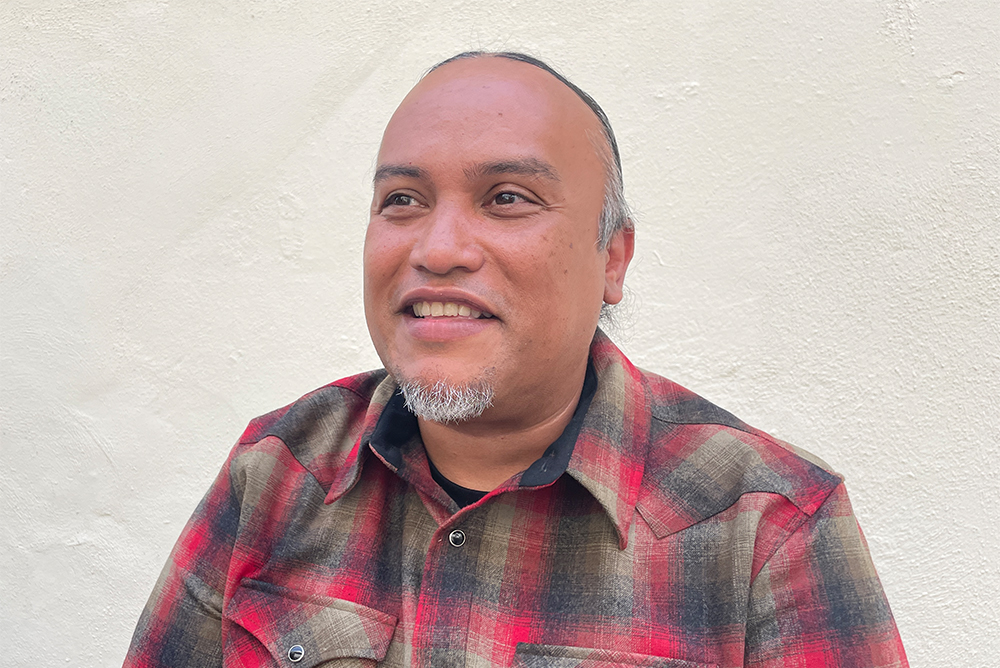
Photo by Sara Suárez.
Joel Garcia is an artist, cultural organizer, and the director of Meztli Projects. Before moderating last May’s Zócalo/Goldhirsh Foundation LA2050 event, “Can We All Live in the Best Version of Los Angeles?,” he joined us in the green room to tell us about his pitbull, being an artist, and punk rock sewing.
Where’s your favorite place to go in Los Angeles?
Lately, the L.A. River near Glendale. There’s a small little park there. You can just park along the street, walk on down; it’s nice. It feels very much like the city. A lot of folks found refuge, a lot of graffiti artists found refuge in the L.A. River because it’s kind of just out there. Nobody’s bothering you, even though there’s a bunch of people there. I usually take my dog there—we go there and nobody makes an issue of it. He gets to run around in the water a little bit. He’s happy.
Tell us about your dog.
He’s a toothless Pitbull. He’s such a people person, such a people dog.
What did you want to be when you were growing up?
I kind of always wanted to be an artist, even though I didn’t know what that was. I guess at some point, I was in gifted classes from, like, first grade, so I was kind of pushed to do something around technology. It was a magnet elementary school. We had this weird relationship with NASA and JPL [Jet Propulsion Laboratory] that I think, for whatever reason, they were studying us. Like how would these kids from the projects respond to access to technology and stuff like that. Looking back, it just feels kind of odd. So I was kind of pushed in that direction. But it’s kind of funny now that the use of technology for making artists is something that’s an emerging part of my work.
What’s the last book that you loved?
I start a lot of books, rarely finish them. But the one that I read through pretty quick was Braiding Sweetgrass. I think that everybody should read it. I think it should be part of all school curriculums when it comes to reconnecting with the cities that we live in and with conversation about accessibility to green space and public space. It is a fundamental switch to recalibrate how we as humans connect to the environment. And that book does a great job of helping us understand that it’s not about what humans need, but what the whole ecosystem of life needs. So that one’s really stuck with me, and I think it’s a super important book.
What’s one of your hidden talents?
I know how to sew. I think that’s seen as a very feminine thing. But I know how to sew. I learned it from my mom. I forgot why I even learned it. But I learned it from my mom and so when folks talk about patterns and all the other stuff I’m like, oh that makes sense. I know what you’re talking about.
What’s the best thing you’ve ever sewed?
As somebody who grew up in the punk rock scene, you don’t want your stitches to be like nice and neat. So I was intentionally going to screw them, you know, they’re gonna look nice and screwed up; like the stitches are evenly dispersed but they look funky.
Who’s your hero?
The saying goes “never meet your heroes.” But I think the one person who, I think, regardless of whatever faults they carried, lived up to that idea of just trying to be a good human was Joe Strummer from The Clash. When I got a chance to meet him, and then kind of remotely work on his album, he was generous when he didn’t have to be. He gave every person the time of day to sit and hear them out.
What was the first community that you chose for yourself?
I would say the punk rock community. I grew up with a bunch of kids my age, so that was more like family than anything—chosen family. But the one instance where I could opt in and be like, I want to be there was the punk rock community.
Do you play any instruments yourself?
I don’t. That’s why I was the artist making the flyers and stuff like that. Here’s a funny thing: For an artist, and somebody who also came up through the graffiti scene, tagging your name up as much as you could was the thing, right? I just bombed the city with my name. But the moment I realized that, like, wait a minute, I can do art, and then it can end up on every bus bench across the city? That’s kind of the same thing, right? Like you drive around and there’s my name, there’s my name, there’s my name, but it was my art. But that was the first time when I realized that I could do this, and have my images just plastered all over the city legally, and get paid for it. That’s kind of what pushed me to do what I do.



